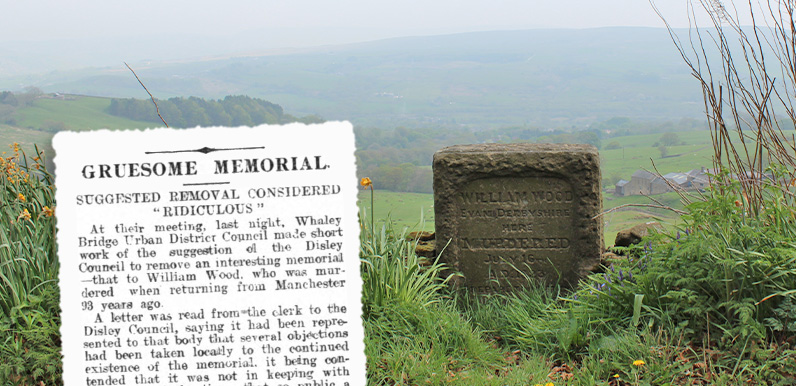Above: It seems that William Wood’s memorial stone, on the back road between Disley and Whaley Bridge, attracted controversy right from the start.
Gail has unearthed a couple of press clippings which show there’s been a fair amount of local opposition to William Wood’s memorial stone over the years. An article in the 19th August 1916 edition of The Sheffield Telegraph reported that the Whaley Bridge Council had received a letter from their colleagues on Disley Council:
…it had been represented to that body that several objections had been taken locally to the continued existence of the memorial, it being contended that it was not in keeping with the spirit of the times that so public a reminder of such a gruesome event should exist, especially on such a popular walk, and that it acted as a deterrent to persons of a timid nature going there.
A member: Is it a sort of tombstone? (Laughter.)
The Council, in ordering that the letter lie on the table, expressed the opinion that the suggestion was “perfectly ridiculous,” and that it would be well if the Disley Council would mind their own business.
A month later, The Sheffield Independent carried a similar report which ended;
…[the stone] was most unsightly and unpleasant, and people objected to passing it at night. He stated that several gentlemen were ready to subscribe for the stone to be reversed.
Another member suggested that the memorial should be made into a drinking fountain.
It transpired, however, that the stone being in the Whaley Bridge Council’s district, that body only has jurisdiction, and they are to be asked if they will consent to have the stone reversed.
This newspaper article from 11th April 1874 describes the unveiling of the memorial stone and hints that there was a fair amount of hostility to the project right from the start…
Memorial stone of a murder
The ceremony of uncovering an indication stone, got up by subscription, in memory of the murder at Higher Disley, of a man named William Wood, some 57 years ago, took place last Saturday, in the presence of a large assemblage of persons who had gathered to witness the event.
The place near the spot is called Longside, situated in the higher parts of Disley township.
After the stone had been uncovered, Mr W.T. Moore ascended it, and proper audience being given, he remarked that he was sorry that no one had come forward to take his position. He felt but too keenly his inability to do justice to the subject; however, they must take the will for the dead.
It was not for him to explain what was their object, or the purpose of their being present that day, as they were all aware of that. He would only simply state the facts how the stone came to be erected.
A few gentlemen opened a subscription, which was so nobly responded to that the matter was taken in hand and all completed within four weeks.
Many opinions had been expressed on the course taken, but he could hurl back the imputations cast upon the committee respecting their object and motives in the erection of that stone.
To his mind there were many which might be advanced, and with justice and right considered worthy of it. One was its being made a terror to evildoers.
Strangers, when viewing such an object in the landscape of nature, would naturally have their thoughts diverted perhaps from viewing nature up to Nature’s God.
That stone would also remind them of the importance of being prepared to meet Him, “for in such an hour as ye think not the Son of Man cometh.”
Little would William Wood have thought when he left his home and little family behind him in the morning, that he would never see them again. Such was the uncertainty of life that they could not be too often or in too many places of the fact, and be prepared to meet their god.
Those were the sincere motives which prompted the gentlemen contributing to place that stone which he stood upon.
Stone after stone had been put on the wall, but often destroyed or removed, and wrong dates put on, leading the traveller or visitor wrong about the time the deed was committed.
This stone, he believed, would put all right on that point, and he hoped would answer the good intentions of the committee.
He trusted that when their names were written in the dust, there would still arise a strong feeling to protect it as there had been that day, as they all knew its purpose ; and as it was public property, so it required public attention.
A collection, which realised a handsome sum, was made, and the surplus will be devoted to repair the village fountain.
